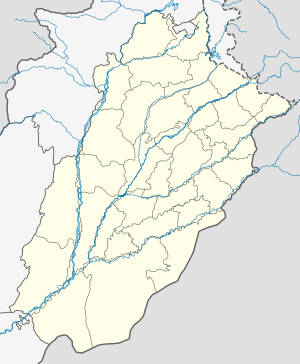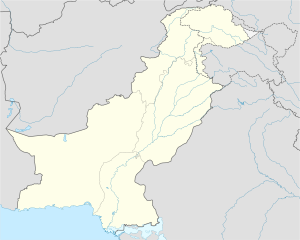| This article needs additional citations for verification. Please help improve this article by adding citations to reliable sources. Unsourced material may be challenged and removed. Find sources: "Zafarwal" – news · newspapers · books · scholar · JSTOR (February 2023) (Learn how and when to remove this message) |
| Zafarwal ظفروال | |
|---|---|
| City | |
  | |
| Coordinates: 32°21′0″N 74°54′0″E / 32.35000°N 74.90000°E / 32.35000; 74.90000 | |
| Country | |
| Province | |
| Division | Gujranwala |
| District | Narowal |
| Area | |
| • Total | 10 km (4 sq mi) |
| • Rank | N/A |
| Population | |
| • Total | 52,639 |
| • Rank | N/A |
| Time zone | UTC+5 (PST) |
| Area code | 0542 |
Zafarwal, Urdu: ظفروال, is a town in the Narowal District of Punjab, Pakistan. It is the administrative hub of Zafarwal Tehsil.
Geography
Zafarwal is situated in the northern region of Punjab, at an elevation of 268 meters (882 feet) above sea level, approximately 7 kilometres from the border with Jammu and Kashmir, India.
History
Zafarwal has a rich history that dates back to the reign of Sultan Mahmud Ghaznavi in 997 CE. Sultan Mahmud Ghaznavid, the son of Sultan Sabuktigin, conquered the Ghaznavid dynasty established by his father and expanded his empire by conquering the Shahis in Kabul and subsequently the Punjab region. The Delhi Sultanate and later the Mughal Empire ruled over the region, leaving a lasting impact on its cultural and architectural heritage. The Punjab region predominantly embraced Islam due to the influence of Sufi saints and their spiritual sites (dargahs) that can still be found throughout the landscape. Zafarwal itself is home to ancient temples, highlighting its religious and cultural diversity.
During the decline of the Mughal Empire, the Sikhs rose to power and conquered Mianwali District. However, the predominantly Muslim population of Zafarwal and its surrounding areas supported the Muslim League and actively participated in the Pakistan Movement, which sought to establish an independent nation for Muslims. Following the Partition of India in 1947, Hindus and Sikhs migrated to India, while Muslim refugees from India settled in Zafarwal Tehsil. This influx of migrants further contributed to the cultural mosaic of the city.
Demography
| Year | Pop. | ±% p.a. |
|---|---|---|
| 1998 | 19,824 | — |
| 2017 | 39,319 | +3.67% |
| 2023 | 52,639 | +4.98% |
| Sources: | ||
The population of Zafarwal comprises diverse ethnic groups, with Punjabis constituting the majority, accounting for approximately 85% of the population. Additionally, there is a significant population of migrants who moved from India to Pakistan during the partition in 1947, commonly referred to as "mohajirs," making up around 25% of the population. Pathans, along with other smaller ethnic groups, constitute around 0.5% of the population.
In terms of language, Punjabi is the predominant language spoken by the people of Zafarwal, followed by Urdu, which serves as the second most widely spoken language.
Islam is the dominant religion in the district, with approximately 97% of the population adhering to the Islamic faith. Christianity represents around 2.5% of the population, while Sikhs and Hindus comprise approximately 0.5% of the total population.
Education
Narowal District is known as the House Of Knowledge. Its literacy rate is higher than neighboring districts. It is the home of various universities and colleges. The top universities Of District Narowal are:
- University of Engineering and Technology Lahore, Narowal campus.
- University College of Veterinary and Animal Sciences
- University Of Narowal
- University of Gujrat Narowal
Zafarwal also has top-notch government and private colleges serving youths.
References
- "URBAN LOCALITIES BY POPULATION SIZE AND THEIR POPULATION BY SEX, ANNUAL GROWTH RATE AND HOUSEHOLD SIZE : CENSUS-2023, Punjab" (PDF).
- "Population by administrative units 1951-1998" (PDF). Pakistan Bureau of Statistics.